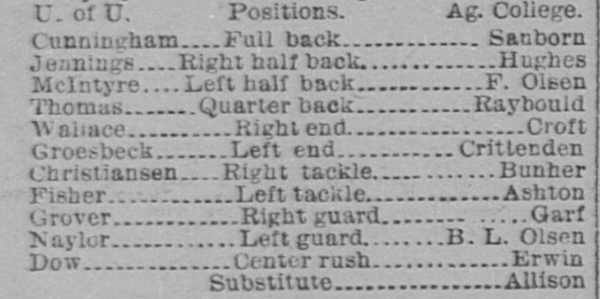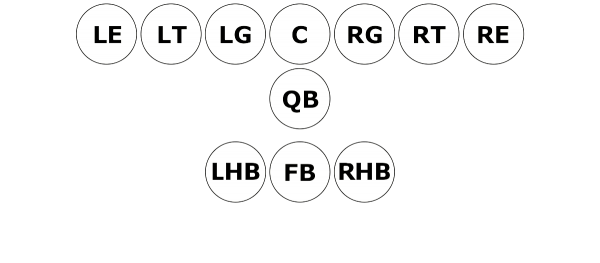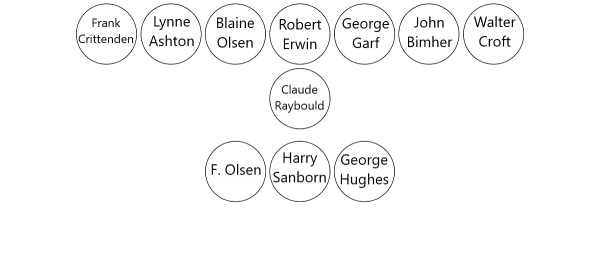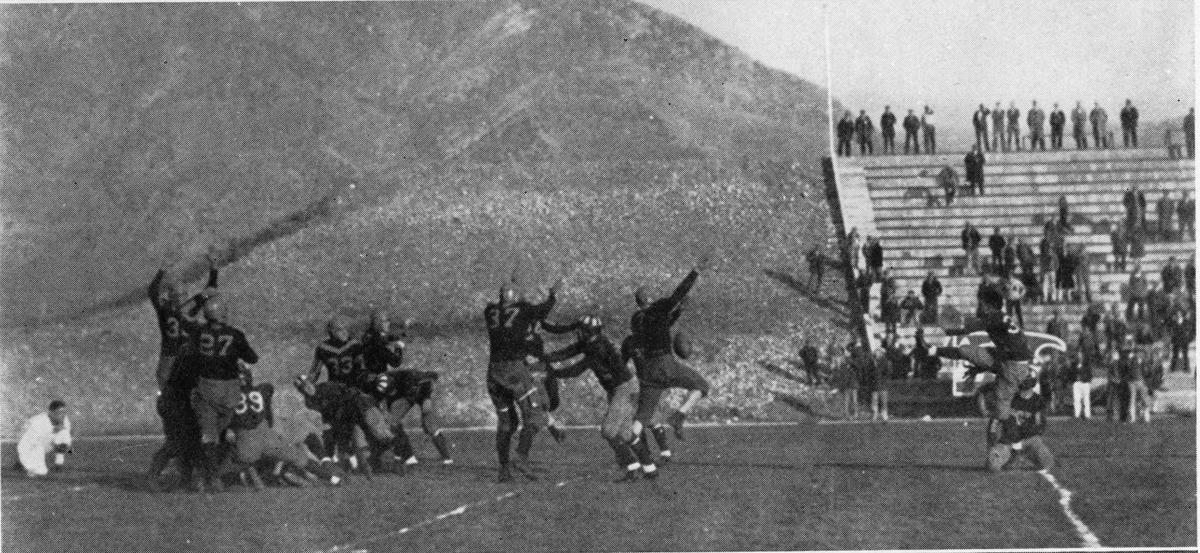Birth of Utah State football: Aggies vs Utes 1892
Utah State may not hold the most prestige as a football program in the Beehive State. They aren’t in a Power 5 conference like the University of Utah or have the history BYU built in the late 20th century. USU does, however, have one feather in its cap in terms of history. Its football program stretches back just as far as anyone in the state, further than BYU’s program, first seen in 1896 (the year Utah joined the Union as the 45th state) and as far back as the U of U. In fact, the Aggies go back exactly as far as the Utes, with both programs playing their respective first official football games in a contest against each other.
The first indications of organized football for the then-named Utah Agricultural College came in May of 1892 when, according to the Ogden Daily Standard, the college put out a challenge to any team in Cache Valley to face their newly formed football squad. Given a lack of records showing any game or even scrimmage, the challenge apparently went unmet.
Around six months later, it was the Aggies who received a summons to the gridiron. Their fellow Utah Territory-sponsored school, the University of Utah, challenged A.C. to a game of football. With official varsity teams and official referees, it would be the first-ever organized collegiate sporting event for both the Logan-based college and their Salt Lake City counterpart.
Initially, the game was to be played on the November 24, 1892 — Thanksgiving Day — but a snowstorm postponed the contest. The next day, the snow remained in a thick coat and had to be cleared off before the start of the game. Even with the field cleared, the grounds were a muddy mess.
At 1:45, the Utes showed up to what is now The Quad, where the games was to be played. And immediately a contrast between the two sides became apparent, a difference summed up wonderfully by a writer for the Logan Journal.
“The University team wore brown pants, white jumpers, red stockings and a smile of confidence,” the author wrote. “The home team wore clothing to protect them from the wind and weather. In other words they dressed as each man pleased.”
This contrast of organized Utes and haphazard Aggies gave the visitors some initial confidence. Even more important was the strategic advantage the Utes supposedly held. The Salt Lake side had been vigorously practicing and had reportedly faced a local Y.M.C.A team five times in scrimmages, giving the Utes experience the A.C could not claim.
The seemingly sole advantage that could be granted to A.C. was the size of many of their players. Nearly every account of the game noted the size difference, including this one from The Herald.
“The University boys felt confident of gaining victory over a team of even weight,” wrote the author. “But when their opponents, hardened to life by herding sheep among the mountains or storing their winter’s hay, came upon the grounds all saw that the weight of the teams was vastly disproportionate in the A.C.’s favor, and a murmur was then heard among the University fellows that their opponents would carry the day.”
One of the captains for the Aggies, F. Olsen, weighed in at a for-the-time sizable 225 pounds, or about 50 pounds heavier than the average college-aged male of the time.
This game, as the aforementioned writer from The Herald put it, pitted “science against weight.”
Twelve men are listed in the archives of history as representatives of the Agricultural College on this fateful day, alongside their reported position on the field.
Harry Sanborn (Captain) — Fullback, George Hughes — Right Halfback, F. Olsen (Captain) — Left Halfback, Claude Raybould — Quarterback, Walter Croft — Right End, Frank Crittenden — Left End, John Bimher — Right Tackle, Lynne Ashton — Left Tackle, George Garf — Right Guard, Blaine Olsen — Left Guard, Robert Erwin — Center, Carl Allison — Substitute

Unfortunately, there is no reliable information on what F. Olsen’s full first name is. An article from the Deseret News in 1992, covering the 100-year anniversary of this game, referred to him as Frank Olsen but no other source, be it newspapers at the time or even Utah State’s archives have his name written down in full.
The coin toss — overseen by referee and Agricultural College professor, W.P. Cutter along with umpire, H.C. Oglesby of the University of Utah — went in favor of the Agricultural College and there commenced the first-ever possession for the Aggies. It went absolutely nowhere and the University took over and dominated most of the first half.
“For a time it seemed as though the University would score a touchdown, for they kept the ball within the A.C.’s territory and close to the goal,” said the Nov. 27 account in The Herald.
One play saw the University nearly strike first. The right halfback for the visitors, a man by the name of Jennings, broke through the otherwise stout defensive form of A.C. and seemingly had a touchdown already in his grasp. But out of nowhere came one of the captains, fullback Harry Sanborn, chasing down Jennings (“with the speed of an antelope” wrote the author of a recap that appeared in The Daily Tribune), tackling him to maintain the shutout. The crowd let out a “wild yell” at this spectacular defense play.
When the halftime whistle blew, neither team had scored. Following a ten-minute halftime, the two sides met once more “all covered with mud” and even “a little blood was seen on the faces of some.”
The start of the second half began very much the way the first one went overall, with the University closing in on a touchdown. But in a reversal of momentum, George Garf of A.C. broke a huge run from around midfield for what became the first-ever touchdown in Utah State football history, which was worth four points based on the scoring rules used in that game. F. Olsen kicked the point after, which was worth two points, to set the score at 6-0.
That lead was nearly short-lived as the Utes nearly ran the ball in themselves, this time it was their quarterback, Thomas (his last name, still no first names available for Utah), who broke a big run. F. Olsen attempted to replicate Sanborn’s heroic first-half touchdown-saving tackle, but accomplished the feat in a more unique way.
“The wild and wooly captain,” The Herald author wrote of Olsen during Thomas’ run, “in his zeal to prevent the University from scoring, jumped on Thomas and tried to cripple him. It is stated on the authority of an A.C. man, that their captain, immediately before the game, instructed his team to weaken the Salt Lake team by crippling their best players. He was evidently following out his own instructions.”
As a punishment for his overzealous actions, Olsen was disqualified from the game, replaced by Carl Allison. Also, as to whether Olsen actually hurt Thomas, it was reported that no notable injuries, other than a few sprains were suffered by any of the players.
Though it was a dirty play, Olsen’s efforts saved the Aggies’ lead and not too long after another touchdown was scored by A.C. This roughly 25-yard scoring play effectively sealed the deal as there was less than three minutes left to play when the ball crossed the goal line. It isn’t recorded who scored this second TD but there is a rather choice description of the hectic play from The Daily Tribune.
“With a grand center rush and a terrific cheer from the crowd the ball was carried over the goal line as the two teams were struggling and rolling each other in the mud. As the mass of tugging humanity arose it presented a unique spectacle. Some rose with aching backs, some with bloody faces, some with limping limbs, all torn and mud-besmeared. Even the referee had lost his spectacles in his attempt to see the touchdown.”
Since F. Olsen was not available to reprise his kicking duties from earlier in the game, Claude Raybould attempted the point(s) after kick which went in to bring the game to its eventual final score of 12-0.
When time was called, the Aggies had their victory. “It was science against weight, but the latter trumped” The Herald said. In fact, The Herald specifically stated that the University had “outplayed their opponents at all points in the science of the game,” and yet the size of A.C. was simply too much to overcome.
This size advantage apparently forced a change in strategy for the Utes. According to The Tribune, the University gave up on trying to break through the A.C. defensive front and attempted to kick field goals which in hindsight turned out to be a poor idea.
As a side note in this historical game, there is the possibility to guess at the formation the Aggies may have used. It’s a question that can only be guessed at, with one possibility being that no coherent formation was present on the Aggies’ side. But given we have position listings it’s reasonable to assume there was at least a base formation and to that end, very informed guesses can be made by using those listed positions and what is known about primitive football offenses.
Walter Camp, the legendary figure of 19th century football, is credited with the invention of the T-Formation which utilized a seven-person offensive line with four backfield players lined up inside the edge set by those linemen. The quarterback lines up directly behind the center with his three backs a couple yards behind him. Those men three stand alongside each other, parallel with the offensive line.
 The proximity of the three halfbacks to the quarterback has varied across the years (along with the various position names), from a mere step behind the QB to three or four yards, but the distinct “T” shape formed by all four of the backfield players is present enough to give the formation its time-honored name. The positions listed in nearly every newspaper account line up immaculately with this formation type and its positions, and using that resource, it’s also possible to re-draw the above image, inserting the names of each A.C. man.
The proximity of the three halfbacks to the quarterback has varied across the years (along with the various position names), from a mere step behind the QB to three or four yards, but the distinct “T” shape formed by all four of the backfield players is present enough to give the formation its time-honored name. The positions listed in nearly every newspaper account line up immaculately with this formation type and its positions, and using that resource, it’s also possible to re-draw the above image, inserting the names of each A.C. man.

For those wondering where Carl Allison, the substitute, would lie in this formation, all indications seem to be that he was a halfback as the man he replaced during the game was F. Olsen.
And so it was on November 25, 1892, the not-yet Utah State University football team defeated its cross-state rival and left the Quad undefeated in its history as a program. Unfortunately, it would be the last time they could say as much as the Aggies’ next game, played in 1896, was a 6-0 loss to Brigham Young College.
@thejwalk67
— jasonswalker94@gmail.com

